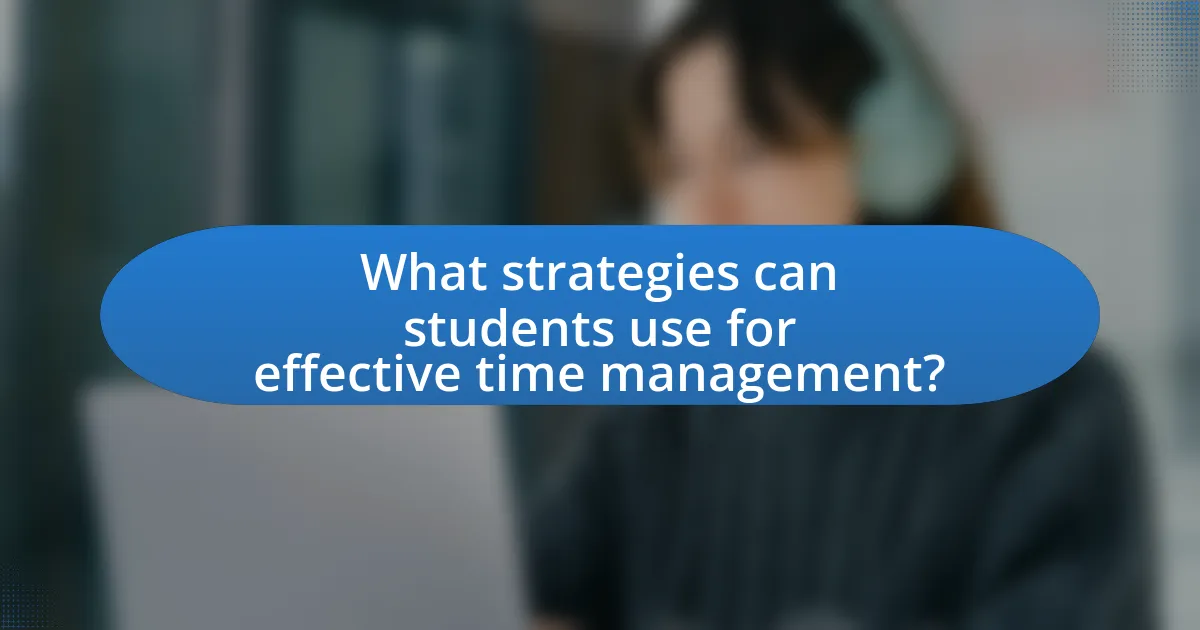The article focuses on the importance of balancing academics and extracurricular activities for students, emphasizing effective time management strategies. It outlines how students can prioritize tasks, set SMART goals, and create structured schedules to enhance their academic performance while engaging in extracurriculars. Key factors influencing time management, such as self-discipline and personal priorities, are discussed, along with the benefits of maintaining a balanced approach. Additionally, the article addresses common challenges students face and provides practical tips for overcoming obstacles and managing stress effectively.

What does it mean to balance academics and extracurriculars?
Balancing academics and extracurriculars means effectively managing time and priorities to ensure success in both areas. This involves allocating sufficient time for studying, completing assignments, and engaging in academic activities while also participating in sports, clubs, or other interests. Research indicates that students who balance these commitments can enhance their time management skills, improve their overall well-being, and achieve higher academic performance. For instance, a study published in the Journal of Educational Psychology found that students involved in extracurricular activities tend to have better grades and higher levels of engagement in school.
How can students effectively manage their time between studies and activities?
Students can effectively manage their time between studies and activities by prioritizing tasks and creating a structured schedule. By identifying urgent and important tasks, students can allocate specific time blocks for studying and extracurricular activities, ensuring that both areas receive adequate attention. Research indicates that students who use time management techniques, such as the Eisenhower Matrix or time blocking, report higher academic performance and lower stress levels. For instance, a study published in the Journal of Educational Psychology found that effective time management correlates with improved academic outcomes, highlighting the importance of balancing commitments.
What are the key factors influencing time management for students?
Key factors influencing time management for students include prioritization, goal setting, and self-discipline. Prioritization allows students to identify which tasks are most important, enabling them to allocate their time effectively. Goal setting provides clear objectives, helping students stay focused and motivated. Self-discipline is crucial for maintaining consistency in following schedules and resisting distractions. Research indicates that students who utilize these strategies tend to achieve better academic outcomes and manage their time more efficiently, as evidenced by a study published in the Journal of Educational Psychology, which found that effective time management correlates with higher academic performance.
How do personal priorities affect the balance between academics and extracurriculars?
Personal priorities significantly influence the balance between academics and extracurricular activities by determining how students allocate their time and energy. When students prioritize academic success, they may dedicate more hours to studying and completing assignments, potentially reducing their involvement in extracurriculars. Conversely, if students value social engagement or skill development through extracurriculars, they may limit their academic focus, which can lead to lower grades or incomplete coursework. Research indicates that students who effectively manage their priorities often achieve a more balanced approach, enhancing both their academic performance and personal growth. For instance, a study published in the Journal of Educational Psychology found that students who set clear priorities and goals were more likely to maintain a healthy balance, resulting in improved overall well-being and academic outcomes.
Why is balancing academics and extracurriculars important for students?
Balancing academics and extracurriculars is important for students because it fosters holistic development and enhances time management skills. Engaging in both areas allows students to cultivate critical thinking, teamwork, and leadership abilities while maintaining academic performance. Research indicates that students involved in extracurricular activities often achieve higher GPAs and have better school attendance, as noted in a study published in the Journal of Educational Psychology, which found that participation in such activities correlates with improved academic outcomes. This balance not only prepares students for future challenges but also promotes well-rounded personal growth.
What are the potential benefits of engaging in extracurricular activities?
Engaging in extracurricular activities offers numerous benefits, including enhanced social skills, improved academic performance, and increased self-esteem. Research indicates that students involved in extracurriculars often develop better teamwork and leadership abilities, which are crucial for personal and professional success. A study published in the Journal of Educational Psychology found that students participating in such activities had higher GPAs and were more likely to pursue higher education. Additionally, involvement in extracurriculars can provide a sense of belonging and community, which contributes positively to mental health and overall well-being.
How can a balanced approach enhance academic performance?
A balanced approach enhances academic performance by allowing students to allocate time effectively between studies and extracurricular activities. This balance reduces stress and prevents burnout, which can negatively impact learning and retention. Research indicates that students who engage in extracurricular activities alongside their academic responsibilities often exhibit improved time management skills and higher overall academic achievement. For instance, a study published in the Journal of Educational Psychology found that students involved in structured extracurricular activities had better grades and higher GPAs compared to those who focused solely on academics. This evidence supports the notion that a balanced approach fosters a more holistic educational experience, ultimately leading to enhanced academic performance.

What strategies can students use for effective time management?
Students can use several strategies for effective time management, including prioritization, scheduling, and setting specific goals. Prioritization involves identifying tasks based on their urgency and importance, allowing students to focus on what needs immediate attention. Scheduling entails creating a structured timetable that allocates specific time blocks for studying, attending classes, and engaging in extracurricular activities. Setting specific, measurable, achievable, relevant, and time-bound (SMART) goals helps students maintain focus and track their progress. Research indicates that students who implement these strategies experience improved academic performance and reduced stress levels, as effective time management leads to better organization and productivity.
How can students create a balanced schedule?
Students can create a balanced schedule by prioritizing their academic responsibilities alongside extracurricular activities. To achieve this, students should first list all their commitments, including classes, study time, and extracurriculars, then allocate specific time blocks for each activity. Research indicates that effective time management can enhance academic performance and reduce stress, as noted in a study by Britton and Tesser (1991) published in the Journal of Educational Psychology, which found that students who planned their schedules reported higher grades and lower anxiety levels. By regularly reviewing and adjusting their schedules based on workload and personal commitments, students can maintain a balance that supports both their academic success and personal interests.
What tools and techniques can assist in time management?
Effective tools and techniques for time management include digital planners, the Pomodoro Technique, and prioritization frameworks like the Eisenhower Matrix. Digital planners, such as Todoist or Google Calendar, allow students to organize tasks and deadlines efficiently, enhancing visibility and accountability. The Pomodoro Technique, which involves working in focused intervals of 25 minutes followed by short breaks, has been shown to improve concentration and productivity. The Eisenhower Matrix helps students prioritize tasks based on urgency and importance, enabling them to focus on what truly matters. These methods are supported by research indicating that structured time management strategies significantly enhance academic performance and reduce stress among students.
How can students prioritize tasks effectively?
Students can prioritize tasks effectively by using a systematic approach that includes identifying deadlines, assessing task importance, and utilizing tools like to-do lists or digital planners. By categorizing tasks based on urgency and significance, students can focus on high-priority assignments first, ensuring that critical deadlines are met. Research indicates that students who employ prioritization techniques, such as the Eisenhower Matrix, which distinguishes between urgent and important tasks, experience improved academic performance and reduced stress levels. This method allows students to allocate their time efficiently, balancing academic responsibilities with extracurricular activities.
What role does goal setting play in balancing academics and extracurriculars?
Goal setting is crucial for effectively balancing academics and extracurricular activities as it provides a clear framework for prioritizing tasks and managing time. By establishing specific, measurable, achievable, relevant, and time-bound (SMART) goals, students can allocate their time efficiently between studying and participating in extracurriculars. Research indicates that students who set goals are more likely to achieve higher academic performance and maintain involvement in extracurricular activities, as they can track their progress and adjust their schedules accordingly. For instance, a study published in the Journal of Educational Psychology found that goal-setting strategies significantly improved students’ time management skills and academic outcomes.
How can setting SMART goals improve time management?
Setting SMART goals improves time management by providing a clear framework that enhances focus and prioritization. SMART goals are Specific, Measurable, Achievable, Relevant, and Time-bound, which allows individuals to break down larger tasks into manageable steps. This structured approach helps students allocate their time effectively, ensuring that they concentrate on high-priority activities that align with their academic and extracurricular commitments. Research indicates that goal-setting can increase performance by 20-25%, demonstrating the effectiveness of SMART goals in optimizing time management.
What are some examples of academic and extracurricular goals?
Academic goals include achieving a specific GPA, mastering a subject, or completing a degree program. For instance, a student may aim to maintain a 3.5 GPA throughout their college years, which demonstrates commitment to academic excellence. Extracurricular goals encompass participating in sports, joining clubs, or engaging in community service. An example is a student setting a goal to lead a student organization, which enhances leadership skills and fosters teamwork. These goals are essential for personal development and can significantly impact a student’s overall educational experience.

What challenges do students face in balancing academics and extracurriculars?
Students face significant challenges in balancing academics and extracurriculars, primarily due to time constraints and competing priorities. The rigorous demands of coursework often require extensive study hours, which can conflict with the time needed for extracurricular activities. Research indicates that students involved in multiple extracurriculars may experience increased stress and time management difficulties, leading to potential declines in academic performance. For instance, a study published in the Journal of Educational Psychology found that students who overcommit to extracurricular activities often report lower grades and higher levels of anxiety. This highlights the critical need for effective time management strategies to navigate these competing demands successfully.
How can students overcome common obstacles?
Students can overcome common obstacles by implementing effective time management strategies. Prioritizing tasks using techniques such as the Eisenhower Matrix helps students distinguish between urgent and important activities, allowing them to focus on what truly matters. Research indicates that students who utilize structured planning tools, like planners or digital calendars, report higher academic performance and reduced stress levels. Additionally, setting specific, measurable goals can enhance motivation and accountability, leading to better management of both academic and extracurricular commitments.
What strategies can help manage stress related to time constraints?
Effective strategies to manage stress related to time constraints include prioritization, time blocking, and setting realistic goals. Prioritization involves identifying tasks based on urgency and importance, allowing individuals to focus on what truly matters. Time blocking is a technique where specific time slots are allocated for different activities, helping to create structure and reduce overwhelm. Setting realistic goals ensures that expectations are achievable within the available time, which can alleviate pressure and enhance productivity. Research indicates that students who utilize these strategies report lower stress levels and improved academic performance, demonstrating their effectiveness in managing time-related stress.
How can students seek support from peers and mentors?
Students can seek support from peers and mentors by actively engaging in study groups, attending workshops, and utilizing office hours. Study groups facilitate collaborative learning, allowing students to share knowledge and resources, which enhances understanding of academic material. Workshops often provide structured environments where students can receive guidance from experienced mentors, fostering skill development. Additionally, office hours offer direct access to instructors or mentors, enabling students to ask questions and seek personalized advice. Research indicates that peer support significantly improves academic performance and retention rates, highlighting the effectiveness of these methods in balancing academics and extracurricular activities.
What are the signs of poor balance between academics and extracurriculars?
Signs of poor balance between academics and extracurriculars include declining academic performance, increased stress levels, and lack of time for personal activities. When students struggle to maintain their grades or experience a drop in test scores, it indicates that academic demands may be overshadowed by extracurricular commitments. Elevated stress can manifest through anxiety, fatigue, or irritability, suggesting that the workload is overwhelming. Additionally, if students find themselves unable to engage in leisure activities or spend time with family and friends, it reflects an imbalance that prioritizes either academics or extracurriculars excessively.
How can students recognize when they are overwhelmed?
Students can recognize when they are overwhelmed by identifying specific signs such as increased anxiety, difficulty concentrating, and physical symptoms like headaches or fatigue. Research indicates that these symptoms often manifest when students face excessive academic and extracurricular demands, leading to stress. For instance, a study published in the Journal of Educational Psychology found that students reporting high levels of stress exhibited significant declines in academic performance and overall well-being. Recognizing these indicators allows students to take proactive steps to manage their workload effectively.
What steps can be taken to regain balance when feeling overwhelmed?
To regain balance when feeling overwhelmed, students should prioritize tasks, set realistic goals, and practice self-care. Prioritizing tasks involves identifying urgent and important activities, which helps in managing time effectively. Setting realistic goals ensures that students do not overcommit, allowing for a more manageable workload. Practicing self-care, such as regular exercise, adequate sleep, and mindfulness techniques, has been shown to reduce stress and improve overall well-being. Research indicates that students who engage in self-care activities report lower levels of stress and higher academic performance, reinforcing the importance of these steps in achieving balance.
What practical tips can students implement for better time management?
Students can implement several practical tips for better time management, including creating a structured schedule, prioritizing tasks, and setting specific goals. A structured schedule helps students allocate time effectively for classes, study sessions, and extracurricular activities, ensuring that all commitments are met. Prioritizing tasks allows students to focus on high-impact assignments first, which can lead to improved academic performance. Setting specific, measurable goals provides clear targets, making it easier to track progress and stay motivated. Research indicates that students who use time management techniques, such as the Eisenhower Matrix for prioritization, report higher academic success and lower stress levels.
How can students utilize planners and calendars effectively?
Students can utilize planners and calendars effectively by consistently scheduling their academic and extracurricular commitments. This practice allows students to visualize their time, prioritize tasks, and allocate specific periods for studying, attending classes, and engaging in activities. Research indicates that students who use planners report improved time management skills and reduced stress levels, as they can track deadlines and commitments more efficiently. By regularly updating their planners with assignments, exams, and events, students can create a structured routine that enhances their productivity and helps maintain a balance between academics and extracurricular activities.
What are some daily habits that promote better time management?
Daily habits that promote better time management include setting specific goals, prioritizing tasks, and utilizing a planner. Setting specific goals helps students focus their efforts on what is most important, while prioritizing tasks ensures that they tackle high-impact activities first. Utilizing a planner, whether digital or paper, allows students to visualize their schedules and deadlines, making it easier to allocate time effectively. Research indicates that students who use planners are more likely to meet deadlines and manage their time efficiently, as they can track their commitments and adjust their schedules accordingly.


